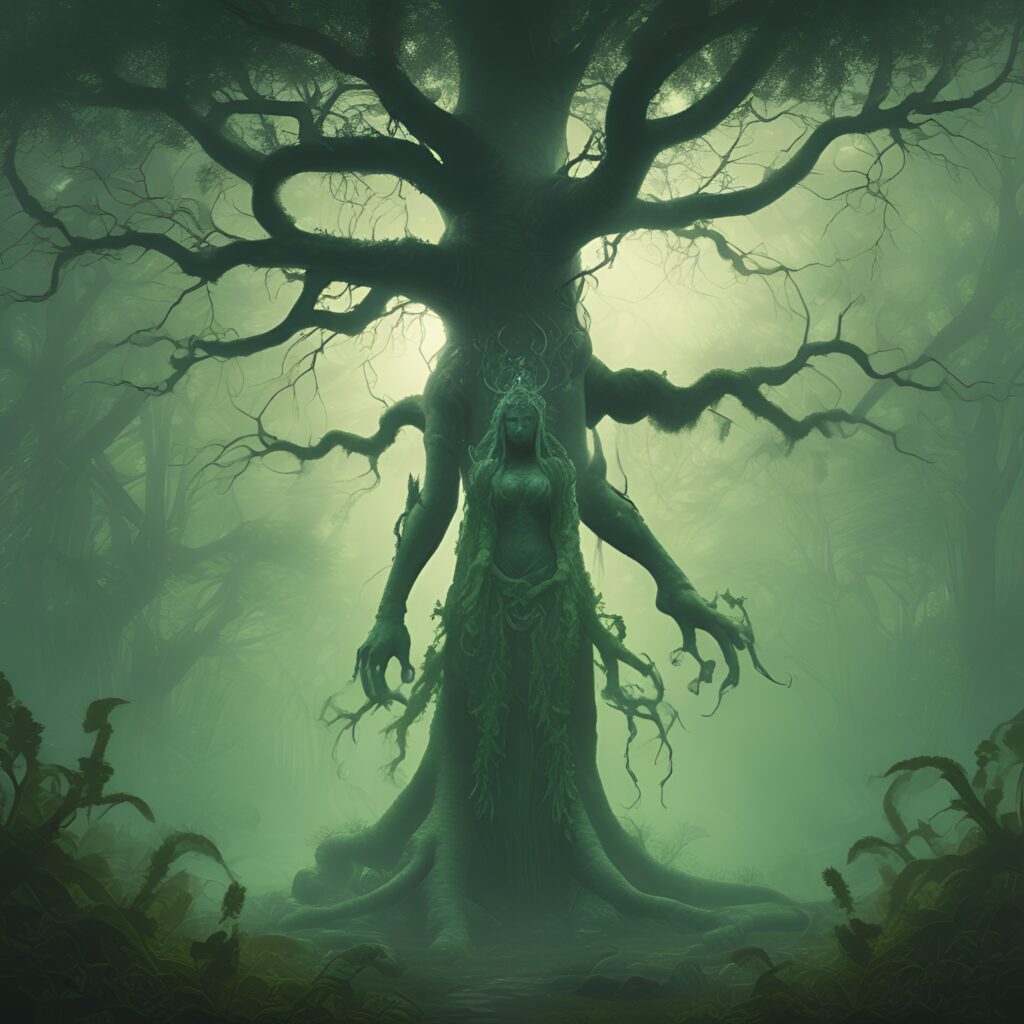TRANSLATED FROM THE HINDI BY ANURADHA DOSAD
SITA OF BANDHAVGARH
– INDIRA DANGI
Translated from the Hindi by Anuradha Dosad
The residents of Madhya Pradesh are no strangers to forests and tigers. So, how can one resist the temptation to visit Bandhavgarh Tiger Ridge? Watching the dense, deep, covered mountains of Satpura from the train window feels like watching rows of saints lost in meditation, with our train passing through them like the devoted Meera! The views from the train heading towards Satpura are so mesmerizing that you can’t help but keep looking.
The Amarkantak Express arrived at Umaria station at 1:30 at night. The driver of the car, who came to pick us up, warned as he loaded our luggage into the trunk,
“If you need to store something in the luggage, do it now. The car won’t be able to stop on the way.”
“Why not?”, we asked.
“Here you can encounter anything from wild elephants to tigers on the road!”
“But the Tiger Reserve is 30 kilometres ahead!”
“Boundaries are for us, not for them!”
On our way, we indeed saw some animals with no respect for boundaries- bison, deer, and even two rabbits!
Sikandar, the driver of our gypsy in the morning, had been driving in the reserve for thirty years. He was a true storyteller of the forest. He knew about every tree, bird, soil, rock, cave and could predict tiger movements so accurately that all the other gypsy drivers would ask him, “Dada! What will the tiger do now?”
Sikandar’s name was actually, Omprakash Tiwari, a lost orphan teenager who had wandered into Bandhavgarh. A kind teacher saw him washing tea cups at a shop and helped him get a job driving a gypsy in the tiger reserve. The teacher affectionately called him Sikandar, and the name stuck. Even now he referred to himself as Sikandar. He settled down with a village girl and started living with his family in a village situated on the border of the forest. He mentioned that a tiger ate his cow the previous night.
“What now?” We asked.
“The forest department will give ten thousand rupees. Four thousand for a goat.” He replied.
“And for humans?” We queried.
“Humans aren’t tiger food, but they enter the area to pluck tendu leaves. The tiger might mistake a person bending down to pluck tendu leaves for a quadruped and attack, but it usually releases them once it realizes the mistake.”
“But why do people enter its core area at all?” asked my twelve-year-old daughter.
In response, my mind started thinking about the inexorably increasing population, limited resources and our limitless greed!
“There is no harvest here. Wild animals destroy everything. The people here survive on what the forest provides, just like the animals. But the forest always gives. Her children can never go hungry.” The driver’s storytelling answered our questions. … And an old memory came alive for me. Urmila was a Baiga girl, a carefree tribal teenager of fifteen or sixteen who neither understood Hindi nor the world of Hindi-speaking people! She hailed from a village of Shahdol or Umaria. She fell in love with a labourer who had come to work on a government project and ran away with him, leaving behind her forest, home, community and family.
When I saw her for the first time in the labour camp near my colony, her playfulness reminded me of a deer from Satpura, so I nicknamed her ‘Satpura’s Deer’. She was a simple girl from a forest village, and her situation was disastrous. The harsh metropolitan life would teach her a bitter lesson. That labourer was already married and lived in some village with his old parents, wife and two sons. In our country, having two sons is considered a sign of good fortune. So, the man, proud of his ‘good fortune’, would send most of his wages to his village. The rest he spent on alcohol.
Fifteen or sixteen-year-old Urmila, an innocent tribal girl, could not understand the urban lifestyle. Why did her husband indulge himself but keep her in poverty? If she drank alcohol naturally, like him or caught a pigeon and cooked it, why did he beat her after enjoying the delicious meal she prepared? And why did he take her wages and send it to his village?
Initially, when her husband beat her, Urmila fought back but gradually, she realized through the scornful reactions of the police, the surrounding labour community and the reproachful responses of some happy housewives that a wife wasn’t supposed to hit her husband, only endure his beatings.
In primitive jungle societies, there might have been equality, but this so-called “civilized” society birthed an ideology ‘going in a palanquin, coming out in a bier’. Women were expected to stay in their husband’s house, enduring all kinds of violence in exchange for food and shelter. This was the unfortunate reality of privileged womanhood of some colony women.
Urmila could not return to her forests and mountains, so after two-forced abortions, she had to settle into this patriarchal society. She began to accept the beatings from her husband and no longer resisted him taking her wages. Perhaps everything would have continued like this, but after she became the mother of two daughters, something changed. She refused to let her husband take her wages or harm her daughters.
One night, when her drunk husband stood up to beat her, she lost her patience. It was as if the beloved deer of Satpura had transformed into a lioness. She turned on her husband, beating him so severely that, at some point during the night, he packed up all his belongings and disappeared forever perhaps to trap some other Urmila in his web.
Now, Urmila sends both her daughters to school. She lives in a one-room government house and sometimes sends some money to her forest village situated in the remote valleys for her parents. How did this exploited woman become a lioness the moment she became a mother!
This morning, while walking in the premises of the Forest Rest House of Tala, I thought of that Baiga girl, Urmila, when I realized—Hey, we are staying here, in this forest courtyard of Urmila, where there are Mahua trees. Bread made from Mahua is called Mahuari and the liquor made from it is called Madhvi in ​​Sanskrit. These are the food, drink and songs, the love and affection of these natives.
Oh! So, this is the Mahua tree Urmila used to sing about. I didn’t remember the song but beneath the tree lay fallen Mahua fruits, a feast spoiled by a group of monkeys. Amidst the busy feast, a small baby langur was being passed gently from one lap to the other.
It was impossible to tell which of these female monkeys was the baby langur’s real mother. Watching them, I was reminded of the old joint families on my father’s side, where small children would sometimes call their grandmother and sometimes their aunt as mother.
And our gypsy moved ahead, headed towards a place renowned as the home of the tigress Sita, the progenitor of countless tigers within this reserve. That place was known as Sita Mandap. But why was it named Sita Mandap? Probably because of its natural beauty and richness, reminiscent of the idealized setting of Sita’s life. Tulsidas describes Janakpuri,
Howt chakit chit kot biloki. sakal bhuvan sobha janu roki – the place, though small, surprises visitors, it seems to contain all beauty of creation.
So, here in Sita Mandap lay the splendour of primeval nature – mountains, cool streams, caves, trees laden with fruits and innumerable peacocks dancing and singing. It was a scene out of a primeval dream. One could only wonder if the primal Mother Goddess was named Sita because of her presence at this mystical place or if this location was named Sita Mandap because a renowned tigress named Sita had lived here once. Often, a place becomes synonymous with its most famous inhabitant.
It was quarter to six in the morning at that time, and fifty tourists, all riding in gypsies, stood breathless and captivated, mesmerized by the spectacle before them. Bajrang, a mighty, young tiger was sleeping with regal ease on the rock across the moat!
All of us waited in breathless anticipation for him to awaken. Each time he lifted his head or flicked his tail to shoo away insects, a ripple of excitement coursed through the crowd. I reflected on the irony of it all- we, who once hunted and nearly drove these magnificent creatures to extinction, were now yearning for a glimpse of them, desperate to capture their majesty through our cameras.
I recalled a Veda Richa,
Mata Bhoomi: Putro Aham Prithivya: Atharvaveda
The land is my mother. I am the son of the earth.
My attention didn’t wander anywhere. While everyone else was focused on the sleeping tiger at quarter past six in the morning, eagerly waiting for the tiger on the rock to wake up, cameras in hand, I found myself absorbed by the nature all around me. The dust-free sky, and those high hills of Bandhavgarh were mesmerizing, with the ancient fort and the temple of Bandhavadhish- Lakshman’s temple standing proudly on the mountain top. It is said that Lakshman became the king here. The temple opened its doors to the public only once a year. The meaning of Bandhavgarh itself is Bandhav (Bandhu), that is, brother’s fort. Ram’s brother’s fort! My eyes searched for the ancient fort on the high mountain, and I wondered about the history embedded in those stones. Meanwhile, my daughter asked Sikandar about the legendary tigress, Sita. Sikandar narrated the tale with enthusiasm:
“Tigress Sita lived here. The rocks you are looking at lie above a cave beneath the water. Bandhavgarh was populated by her tiger cubs. She had a friend who lived in the forest. She lived here with her children.”
“Alone?? Didn’t any other tiger attack her?” My daughter asked worriedly.
“Ah, my little one! Who could dare attack Sita? No one could touch her or her cubs! Many tigers wandered to this side, but Sita fought them off and drove them away. She was so powerful that even if two tigers had come together to fight her, they would not stand a chance! She had a protective aura about her!”
As I listened to Sikandar’s story, my gaze drifted back to the invisible Bandhavgarh Fort on the distant high mountain. My eyes settled on the deep Sita Mandap and the rock. What an intriguing creation of nature!
Nearby, I noticed what appeared to be two eggs, perfectly camouflaged with the rock’s surface. Wait—this was no coincidence; it was a bird! A bird was perched on the rock, very close to our gypsy’s tire, half-asleep with its eyes slightly open, blended seamlessly with its surroundings, embodying the perfect balance of nature’s artistry.
Sikander gently stopped me from speaking too loudly,
“Shhh! If you speak loudly, everyone will know what you have seen. And they will start taking photos of it, leaving us out. It’s a rare stroke of luck to spot this bird. Now that you have, enjoy observing it to your heart’s content. Many photographers search for the nightjar but rarely find it here.”
“Nightjar!”
“Yes.” Sikander nodded, “She can see only at night. During the day, she can’t see well so she sits near her eggs with her eyes closed.”
“But out in the open? On a rock? What if a predator finds her or her eggs? And why doesn’t this bird have a companion here?”
Sikandar laughed, “In the jungle there is only mother, no father.”
Just then, a flurry of excitement rippled through the crowd as the tiger Bajrang rose from the rock across the moat. In the blink of an eye, dozens of cameras started clicking, capturing the majestic scene. Bajrang, the current king of this territory, strode confidently with his powerful gait, making his way down toward the cave.
Sikander turned the gypsy around, “Now he won’t be coming out of the cave. Let everyone stand waiting for him. Come, I have to show you the reclining statue of Lord Vishnu and also the river Ganga at his feet.”
We took a new route from Sita Mandap. A group of wild elephants must have passed along the unpaved road at night, we could imagine their presence from their footprints. Here stood Anarkali, an elephant belonging to the forest department. About two years ago, she had run off with a wild elephant that had appeared one night. It took the forest department several days and considerable effort to locate her and bring her back to the base camp. Now, twenty-two months later, she gave birth to a baby elephant. The wild elephant still occasionally came to the base camp to visit his Anarkali. It was as if their bond transcended the barriers of captivity and freedom. We saw the elephant base camp from a distance near the Tala Forest entry area. A mahout was bathing an elephant in the river, and it was a sight to behold. This particular elephant was eighty years old. His majestic appearance, even from afar, radiated the aura of a proud grandfather of the clan.
Stopping the gypsy on the new path, Sikandar pointed out the territorial marks made by the claws of Bajrang, the tiger, on an Arjuna tree, reaching up to a height of thirteen feet. If any other male tiger came here, it had to leave a mark higher than the king’s to challenge him and enter his territory for a fight. We continued our journey and soon came across a serene pond along the way. As we approached, a flock of hundreds of butterflies took off from the shore, their delicate wings fluttering and spreading all around like some herald of good news. Nearby, a group of sambar females waded into the pond with their young, feeding on the aquatic vegetation that grew along the banks. About fifty deer could be seen grazing here and there, their elegant forms moving gracefully through the landscape in the morning air. Their companion, a lone monkey, watched us with an almost indifferent gaze, as if we are mere visitors in his ancient realm. Towering above us were the ancient trees, from which massive vines hung low, resembling the long, flowing hair of a forest goddess, adding an aura of mystery and enchantment to the surroundings.
Also, read Wyrd Words: Personal Reflections On the Art of Horror (Part IX) written by Grandfather Hu, and published in The Antonym.
| Wyrd Words: Personal Reflections On the Art of Horror (Part IX) — Grandfather Hu
Follow The Antonym’s Facebook page and Instagram account for more content and interesting updates.




























Very nicely scripted and presented. This gives a wonderful picture of Bandhavharh. One can visualize by reading
Just a wonderful work Ma’am….I loved it❤️
Such a wonderful work ma’am ❤️ I loved it
Personally I am an admirer of the Translator, I usually prefer to go through her writings . She is an excellent writer who can describe the theme in detail easily by her wonderful game of words 😍 . Her words speaks a lot that gives me unending happiness 😍❤️ , Amazing ❤️ . Waiting for more 😍.
Personally , I am an admirer of the Translator 😍. I usually go through her writings . This is also a masterpiece , she explained with her wonderful words .
Her words are like ” Spontaneous overflow of powerful feeling” ❤️.
Enjoyed the text a lot 😍.
Waiting for more stories ❤️🙏